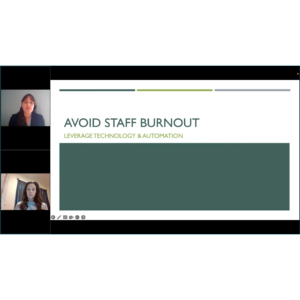Hearing Loss: Perceptions and Solutions
| BY AMANDA D. NICHOLS |
| Hearing Loss: Perceptions and Solutions Hearing loss can be dealt with effectively to improve a resident’s quality of life |
| Hearing loss is the third most common chronic condition found in the elderly population, following hypertension and arthritis.1 According to a 1999 Centers for Disease Control and Prevention study, 21% of nursing home residents have some degree of hearing loss.2 This figure, however, is probably an underestimate because hearing impairment tends to be overlooked or underdiagnosed in the long-term care setting. Communication difficulties are not the only problems associated with hearing impairment. Hearing loss can lead to depression, social isolation, stress, and functional problems, such as impaired balance. Hearing loss and dementia have several symptoms in common, such as confusion, withdrawal, irritability, disorientation, and inappropriate responses, that can lead to a diagnosis of a more severe cognitive impairment than is truly the case. When furnished with hearing amplification, residents with dementia score better on cognitive screening tests than those without amplification.3 When a proper screening program is in place and assistive listening devices are used, continuing decreases in quality of life and functional abilities can be stabilized. Although there is no universal protocol for screening hearing in nursing home residents, helpful assessment tools do exist. The Hearing Handicap Inventory for the Elderly is a widely used screening questionnaire. This 10-item questionnaire assesses the emotional and social impacts of hearing loss on residents. Answers are given in a “Yes,” “No,” or “Sometimes” format and then scored accordingly. Scoring and interpretation instructions are provided (see table). If a resident fails the screening, a full audiologic evaluation performed by a state-licensed, American Speech-Language-Hearing Association (ASHA)’certified audiologist is recommended. A comprehensive audiologic exam is considered the standard method for determining the type and severity of hearing loss and to rule out middle-ear pathology. In addition, it provides essential information in determining candidacy for hearing aids, assistive listening devices (ALDs), and aural rehabilitation. Medicare Part B covers hearing evaluations (CPT code 92557) when they are deemed medically necessary, such as to rule out a middle-ear pathology as a cause for a de-crease in hearing. Otoscopic ear examination should be performed in conjunction with an audiologic evaluation to exclude other treatable causes of hearing loss, including cerumen (earwax) impaction, ear infections, and tympanic membrane perforations. In fact, cerumen impaction is one of the most common causes of hearing loss in the elderly and can be attributed to a hearing loss of up to 40 decibels.4 Aural rehabilitation and amplification should be offered to residents once they have been qualified as candidates for these services. |
| Helpful Resources American Speech-Language-Hearing Association, www.asha.org Better Hearing Institute, www.betterhearing.org Centers for Medicare & Medicaid Services, www.cms.hhs.gov HITEC Group, Ltd., www.hitec.com Williams Sound Corp., www.williamssound.com |
| Aural Rehabilitation Aural rehabilitation must be deemed medically necessary to be a covered service under Medicare. Medical necessity is determined by the recommendations of an audiologist and speech-language pathologist, and depends on determination that a hearing aid or an ALD in itself would not “sufficiently meet the patient’s functional communication needs.”5 This type of speech-language therapy is reimbursable under CPT code 92507 which, under Medicare, is described as the “treatment of speech, language, voice communication, and/or auditory processing disorder.” Amplification According to ConsumerAffairs.com, the average cost of a pair of hearing aids in 2004 was $2,300.7 Cost can be prohibitive for the elderly, who might rely strictly on Medicare and Medigap to meet their healthcare needs. In fact, of the 10 standard Medigap plans available, not one covers the cost of hearing aids. A few commercial insurance companies reimburse for hearing aids, but coverage varies greatly. Medicaid coverage for hearing aids also varies greatly, depending on the state. Other Amplification Options Alerting devices can help the hearing-impaired perceive environmental sounds, such as those made by a doorbell, telephone, or fire alarm. These devices rely typically on flashing lights or vibration to communicate. They provide an important service to those who want to maintain their independence and still ensure their safety. ALDs help to address communication problems by amplifying sounds and are typically stand-alone devices; i.e., no hearing aids are required. There are many ALD options available, including telephone amplifying devices, TV listening systems, and personal listening systems. |
| Table. Hearing Handicap Inventory for the Elderly ‘ Short Version. Instructions: Answer Yes, No or Sometimes for each question. Do not skip a question if you avoid a situation because of hearing problems. If you use hearing aids or assistive devices, answer according to the way you hear without amplification. Scoring: No = 0; Sometimes = 2; Yes = 4. Interpretation of Scoring: 0-8 = no handicap; 10-24 = mild to moderate handicap; 26-40 = severe handicap. |
| 1. Does a hearing problem cause you to feel embarrassed when you meet mew people? |
| 2. Does a hearing problem cause you to feel frustrated when talking to members of your family? |
| 3. Do you have difficulty hearing when someone speaks in a whisper? |
| 4. Do you feel handicapped by a hearing impairment? |
| 5. Does a hearing problem cause you difficulty when visiting friends, relatives, or neighbors? |
| 6. Does a hearing problem cause you to attend religious services less often than you would like? |
| 7. Does a hearing problem cause you to have arguments with family members? |
| 8. Does a hearing problem cause you difficulty when listening to TV or radio? |
| 9. Do you feel that any difficulty with your hearing limits or hampers your personal or social life? |
| 10. Does a hearing problem cause you difficulty when in a restaurant with relatives or friends? |
| Source: Ventry IM, Weinstein BE. Identification of elderly people with hearing problems. American Speech-Language-Hearing Association 1983;25:37-42. |
| Amplified telephones increase the volume of sound emanating from a telephone handset. These generally have adjustable volume and tone controls for personal listening preference and to help make it easier to hear difficult voices (i.e., women’s and children’s voices); they are usually hearing aid’compatible. Special amplifying devices are available that can be attached to an existing telephone to serve the same purpose. TV listening systems typically use infrared technology to send sound from a transmitter plugged into the television to a headset receiver with an independent volume control. (It’s no wonder that they are commonly referred to as “marriage savers.”) Personal listening systems are perhaps the most useful to nursing home residents. These systems are inexpensive compared with hearing aids and can be much easier to handle. Personal amplifiers are handheld, battery-operated devices that are perfect for one-on-one conversation or even watching television. Most personal amplifiers are hardwired, meaning that a microphone is attached to a receiver by a wire. An example of a personal amplifier is the Pocketalker Pro by Williams Sound. It comes with several headset options, a carrying case, and a microphone extension cord for a television. It operates on two AA batteries (with optional recharger) and comes standard with a five-year warranty. There are times, however, when the resident or facility needs a less expensive option. In our practice, we recommend the Turbo Ear to fill this need. The Turbo Ear comes standard with in-the-ear headphones (other options may be available) and uses one AAA battery. The Turbo Ear does not provide as much amplification as the Pocketalker, but it can be quite helpful when trying to communicate with a hearing-impaired resident who has budget constraints. Other personal amplifying systems are available. An audiologist should be consulted to help select the most appropriate device for the individual patient. Conclusion Amanda D. Nichols is Business Manager for Southeastern Hearing Services, a private audiology practice based in Tuscaloosa, Alabama. Its clients include more than 100 nursing homes in Alabama, Mississippi, and Arkansas. For further information, phone (205) 391-9876 or visit www.forhearing.com. To send your comments to the author and editors, e-mail nichols1006@nursinghomesmagazine.com. |
| Note: The author’s mention of specific products in this article should not be taken as an endorsement by Nursing Homes/Long Term Care Management. |
| References 1.Cruikshanks KJ, Wiley TL, Tweed TS, et al. Prevalence of hearing loss in older adults in Beaver Dam, Wisconsin. The Epidemiology of Hearing Loss Study. American Journal of Epidemiology 1998;148:879-86. 2.Jones A. The National Nursing Home Survey: 1999 summary. National Center for Health Statistics, Centers for Disease Control and Prevention, Department of Health and Human Services. Vital and Health Statistics 2002;13(152). Available at: www.cdc.gov/nchs/data/series/sr_13/sr13_152.pdf. 3.Weinstein BE, Amsel L. Hearing loss and senile dementia in the institutionalized elderly. Clinical Gerontologist 1986; 4:3-15. 4.Lewis-Cullinan C, Janken JK. Effect of cerumen removal on the hearing ability of geriatric patients. Journal of Advanced Nursing 1990;15:594-600. 5.CMS Manual System: Pub 100-02 Medicare Benefit Policy, Transmittal 36, Change Request 3648. Centers for Medicare & Medicaid Services, Department of Health and Human Services. June 24, 2005. Available at: www.cms.gov/Transmittals/downloads/R36BP.pdf. 6.Popelka MM, Cruickshanks KJ, Wiley TL, et al. Low prevalence of hearing aid use among older adults with hearing loss: The Epidemiology of Hearing Loss Study. Journal of the American Geriatrics Society. 1998;46:1075-8. 7.Allen J. Hearing aids becoming easier & cheaper to buy. ConsumerAffairs.com; June 18, 2004. Available at: www.consumeraffairs.com/health/hearing/hearing_aids_01.html. |
I Advance Senior Care is the industry-leading source for practical, in-depth, business-building, and resident care information for owners, executives, administrators, and directors of nursing at assisted living communities, skilled nursing facilities, post-acute facilities, and continuing care retirement communities. The I Advance Senior Care editorial team and industry experts provide market analysis, strategic direction, policy commentary, clinical best-practices, business management, and technology breakthroughs.
I Advance Senior Care is part of the Institute for the Advancement of Senior Care and published by Plain-English Health Care.
Related Articles
Topics: Articles , Clinical , Technology & IT











